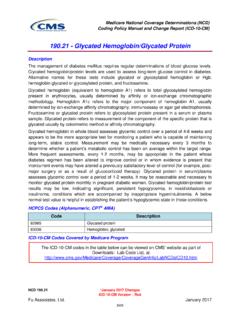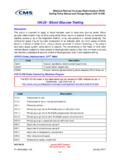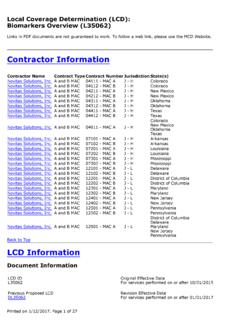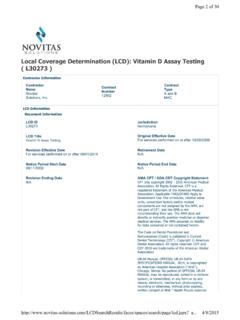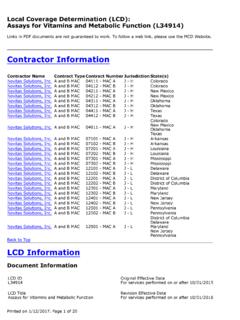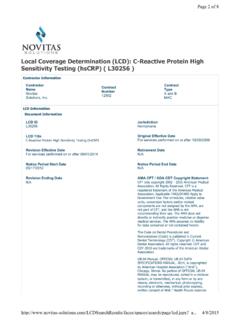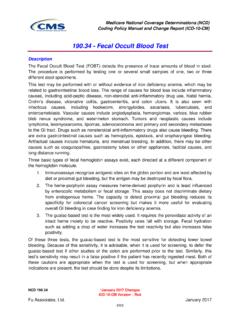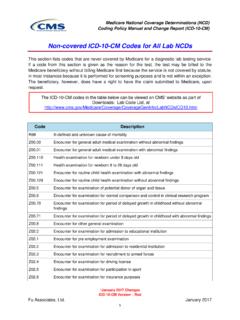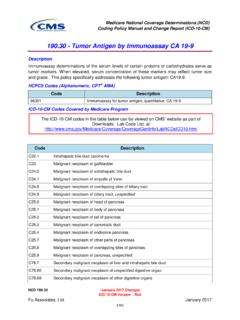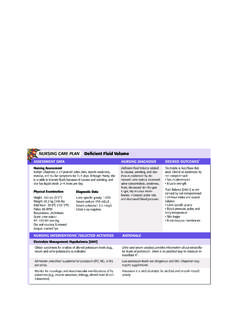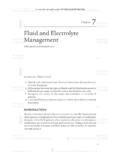Transcription of National Coverage Determination Procedure Code: 87086 ...
1 National Coverage Determination Procedure Code: 87086 , 87088. Urine Culture, Bacterial CMS Policy Number: Back to NCD List Description: A bacterial urine culture is a laboratory Procedure performed on a urine specimen to establish the probable etiology of a presumed urinary tract infection. It is common practice to do a urinalysis prior to a urine culture. A urine culture may also be used as part of the evaluation and management of another related condition. The Procedure includes aerobic agar-based isolation of bacteria or other cultivable organisms present, and quantitation of types present based on morphologic criteria. Isolates deemed significant may be subjected to additional identification and susceptibility procedures as requested by the ordering physician. The physician's request may be through clearly documented and communicated laboratory protocols. Indications: 1. A patient's urinalysis is abnormal suggesting urinary tract infection, for example, abnormal microscopic (hematuria, pyuria, bacteriuria); abnormal biochemical urinalysis (positive leukocyte esterase, nitrite, protein, blood); a Gram's stain positive for microorganisms; positive bacteriuria screen by a non-culture technique; or other significant abnormality of a urinalysis.
2 While it is not essential to evaluate a urine specimen by one of these methods before a urine culture is performed, certain clinical presentations with highly suggestive signs and symptoms may lend themselves to an antecedent urinalysis Procedure where follow-up culture depends upon an initial positive or abnormal test result. 2. A patient has clinical signs and symptoms indicative of a possible urinary tract infection (UTI). Acute lower UTI may present with urgency, frequency, nocturia, dysuria, discharge or incontinence. These findings may also be noted in upper UTI with additional systemic symptoms (for example, fever, chills, lethargy); or pain in the costovertebral, abdominal, or pelvic areas. Signs and symptoms may overlap considerably with other inflammatory conditions of the genitourinary tract (for example, prostatitis, urethritis, vaginitis, or cervicitis). Elderly or immunocompromised patients, or patients with neurologic disorders may present atypically (for example, general debility, acute mental status changes, declining functional status).
3 3. The patient is being evaluated for suspected urosepsis, fever of unknown origin, or other systemic manifestations of infection but without a known source. Signs and symptoms used to define sepsis have been well established. 4. A test-of cure is generally not indicated in an uncomplicated infection. However, it may be indicated if the patient is being evaluated for response to therapy and there is a complicating co- existing urinary abnormality including structural or functional abnormalities, calculi, foreign bodies, or ureteral/renal stents or there is clinical or laboratory evidence of failure to respond as described in Indications 1 and 2. 5. In surgical procedures involving major manipulations of the genitourinary tract, preoperative examination to detect occult infection may be indicated in selected cases (for example, prior to renal transplantation, manipulation or removal of kidney stones, or transurethral surgery of the bladder or prostate).
4 6. Urine culture may be indicated to detect occult infection in renal transplant recipients on immunosuppressive therapy. Limitations: 1. CPT 87086 may be used one time per encounter. 2. Colony count restrictions on Coverage of CPT 87088 do not apply as they may be highly variable according to syndrome or other clinical circumstances (for example, antecedent therapy, collection time, and degree of hydration). 3. CPT 87088, 87184, and 87186 may be used multiple times in association with or independent of 87086 , as urinary tract infections may be polymicrobial. 4. Testing for asymptomatic bacteriuria as part of a prenatal evaluation may be medically appropriate but is considered screening and therefore not covered by Medicare. The Preventive Services Task Force has concluded that screening for asymptomatic bacteriuria outside of the narrow indication for pregnant women is generally not indicated. There are insufficient data to recommend screening in ambulatory elderly patients including those with diabetes.
5 Testing may be clinically indicated on other grounds including likelihood of recurrence or potential adverse effects of antibiotics, but is considered screening in the absence of clinical or laboratory evidence of infection. To review all requirements of this policy, please see: CMS NCD listing by Chapter Covered ICD-10 Codes. ICD-10 Descriptor Salmonella sepsis Tuberculosis of prostate A34 Obstetrical tetanus Sepsis due to streptococcus, group A. Sepsis due to streptococcus, group B. Sepsis due to Streptococcus pneumoniae Other streptococcal sepsis Streptococcal sepsis, unspecified Sepsis due to Methicillin susceptible Staphylococcus aureus Sepsis due to Methicillin resistant Staphylococcus aureus Sepsis due to other specified staphylococcus Sepsis due to unspecified staphylococcus Sepsis due to Hemophilus influenzae Sepsis due to anaerobes Gram-negative sepsis, unspecified Sepsis due to Escherichia coli [E.]
6 Coli]. Sepsis due to Pseudomonas Sepsis due to Serratia Other Gram-negative sepsis Sepsis due to Enterococcus Other specified sepsis Sepsis, unspecified organism Actinomycotic sepsis Chlamydial cystitis and urethritis Chlamydial vulvovaginitis Chlamydial female pelvic inflammatory disease D65 Disseminated intravascular coagulation Congenital agranulocytosis Agranulocytosis secondary to cancer chemotherapy Other drug-induced agranulocytosis Neutropenia due to infection Cyclic neutropenia Other neutropenia Neutropenia, unspecified Other specified disorders of white blood cells Drug/chem diabetes mellitus w diabetic nephropathy Drug/chem diabetes w diabetic chronic kidney disease Drug/chem diabetes w oth diabetic kidney complication Type 2 diabetes mellitus with ketoacidosis without coma Type 2 diabetes mellitus with ketoacidosis with coma Acidosis Mixed disorder of acid-base balance Other somatoform disorders Postviral fatigue syndrome Right heart failure due to left heart failure Biventricular heart failure End stage heart failure Other heart failure J80 Acute respiratory distress syndrome Acute and subacute hepatic failure without coma Acute and subacute hepatic failure with coma Central hemorrhagic necrosis of liver Periodic fever syndromes Glomerular disease in systemic lupus erythematosus Tubulo-interstitial neuropath in sys lupus erythematosus Sicca syndrome with tubulo-interstitial nephropathy Other
7 Dorsalgia Dorsalgia, unspecified Acute nephritic syndrome with minor glomerular abnormality Acute neph syndrome w focal and segmental glomerular lesions Acute nephritic syndrome w diffuse membranous glomrlneph Acute neph syndrome w diffuse mesangial prolif glomrlneph Acute neph syndrome w diffuse endocaplry prolif glomrlneph Acute nephritic syndrome w diffuse mesangiocap glomrlneph Acute nephritic syndrome with dense deposit disease Acute nephritic syndrome w diffuse crescentic glomrlneph Acute nephritic syndrome with other morphologic changes Acute nephritic syndrome with unsp morphologic changes Rapidly progr nephritic syndrome w minor glomerular abnlt Rapidly progr neph synd w focal and seg glomerular lesions Rapidly progr neph syndrome w diffuse membranous glomrlneph Rapidly progr neph synd w diffus mesangial prolif glomrlneph Rapid progr neph synd w diffus endocaplry prolif glomrlneph Rapidly progr neph
8 Syndrome w diffuse mesangiocap glomrlneph Rapidly progr nephritic syndrome w dense deposit disease Rapidly progr neph syndrome w diffuse crescentic glomrlneph Rapidly progr nephritic syndrome w oth morphologic changes Rapidly progr nephritic syndrome w unsp morphologic changes Unsp nephritic syndrome with minor glomerular abnormality Unsp neph syndrome w focal and segmental glomerular lesions Unsp nephritic syndrome w diffuse membranous glomrlneph Unsp neph syndrome w diffuse mesangial prolif glomrlneph Unsp neph syndrome w diffuse endocaplry prolif glomrlneph Unsp nephritic syndrome w diffuse mesangiocap glomrlneph Unspecified nephritic syndrome with dense deposit disease Unsp nephritic syndrome w diffuse crescentic glomrlneph Unsp nephritic syndrome with other morphologic changes Unsp nephritic syndrome with unspecified morphologic changes Isolated proteinuria with minor glomerular abnormality Isolated protein w focal and segmental glomerular lesions Isolated proteinuria w diffuse membranous glomerulonephritis Isolated proteinuria w diffuse mesangial prolif glomrlneph Isolated proteinuria w diffuse endocaplry prolif glomrlneph Isolated proteinuria w diffuse mesangiocapillary glomrlneph Isolated proteinuria with dense deposit disease Isolated proteinuria w diffuse crescentic glomerulonephritis Isolated proteinuria with other morphologic lesion Isolated proteinuria with unspecified morphologic lesion Hereditary nephropathy, NEC w minor glomerular abnormality Heredit neuropath, NEC w focal and seg glomerular lesions Hereditary nephropathy, NEC w diffuse membranous glomrlneph Heredit neuropath, NEC w diffuse mesangial prolif glomrlneph Heredit neuropath, NEC w diffus endocaplry prolif glomrlneph Hereditary nephropathy, NEC w diffuse mesangiocap glomrlneph Hereditary nephropathy.
9 NEC w dense deposit disease Hereditary nephropathy, NEC w diffuse crescentic glomrlneph Hereditary nephropathy, NEC w oth morphologic lesions Hereditary nephropathy, NEC w unsp morphologic lesions N08 Glomerular disorders in diseases classified elsewhere N10 Acute pyelonephritis Nonobstructive reflux-associated chronic pyelonephritis Chronic obstructive pyelonephritis Other chronic tubulo-interstitial nephritis Chronic tubulo-interstitial nephritis, unspecified N12 Tubulo-interstitial nephritis, not spcf as acute or chronic Hydronephrosis with ureteropelvic junction obstruction Hydronephrosis w ureteral stricture, NEC. Hydronephrosis with renal and ureteral calculous obstruction Hydroureter Crossing vessel and stricture of ureter w/o hydronephrosis Pyonephrosis Vesicoureteral-reflux, unspecified Vesicoureteral-reflux without reflux nephropathy Vesicoureter-reflux w reflux neuropath w/o hydrourt, unil Vesicoureter-reflux w reflux neuropath w/o hydrourt, bi Vesicoureter-reflux w reflux nephropathy w/o hydrourt, unsp Vesicoureter-reflux w reflux neuropath w hydrourt, unil Vesicoureter-reflux w reflux neuropath w hydrourt, bilateral Vesicoureter-reflux w reflux nephropathy w hydroureter, unsp Other obstructive and reflux uropathy Obstructive and reflux uropathy, unspecified Analgesic nephropathy Nephropathy induced by oth drug/meds/biol subst Neuropath induced by unsp drug, medicament or biolg sub Nephropathy induced by heavy metals Toxic nephropathy.
10 Not elsewhere classified Balkan nephropathy Renal and perinephric abscess Other specified renal tubulo-interstitial diseases Renal tubulo-interstitial disease, unspecified N16 Renal tubulo-interstitial disord in diseases classd elswhr Acute kidney failure with acute cortical necrosis Acute kidney failure with medullary necrosis End stage renal disease Calculus of kidney Calculus of ureter Calculus of kidney with calculus of ureter Urinary calculus, unspecified Calculus in bladder Calculus in urethra Other lower urinary tract calculus Calculus of lower urinary tract, unspecified N22 Calculus of urinary tract in diseases classified elsewhere N23 Unspecified renal colic Ischemia and infarction of kidney Cyst of kidney, acquired Hypertrophy of kidney Megaloureter Nephroptosis Pyelitis cystica Pyeloureteritis cystica Ureteritis cystica Other specified disorders of kidney and ureter Disorder of kidney and ureter, unspecified N29 Oth disorders of kidney and ureter in diseases classd elswhr Acute cystitis without hematuria Acute cystitis with hematuria Interstitial cystitis (chronic) without hematuria Interstitial cystitis (chronic)
